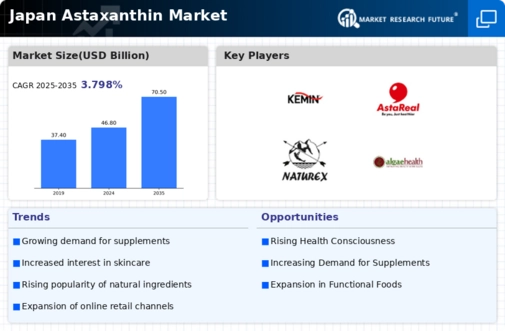Expansion of E-commerce Platforms
The astaxanthin market is witnessing a significant expansion of e-commerce platforms in Japan, which is reshaping the way consumers access health supplements. The convenience of online shopping, coupled with the growing trend of health-conscious consumers, is driving the demand for astaxanthin products through digital channels. E-commerce sales of dietary supplements in Japan are projected to grow at a CAGR of approximately 8% over the next few years. This shift towards online retail not only provides consumers with a wider range of astaxanthin products but also facilitates informed purchasing decisions through access to product information and reviews. As e-commerce continues to thrive, it is likely to play a crucial role in the growth and accessibility of the astaxanthin market.
Growing Awareness of Health Benefits
The astaxanthin market in Japan is experiencing a notable surge in consumer awareness regarding the health benefits associated with astaxanthin. This carotenoid is recognized for its antioxidant properties, which may contribute to improved skin health, enhanced athletic performance, and reduced inflammation. As consumers increasingly seek natural alternatives to synthetic supplements, the demand for astaxanthin is likely to rise. Reports indicate that the market for dietary supplements in Japan is projected to reach approximately $10 billion by 2026, with astaxanthin playing a pivotal role in this growth. The increasing focus on holistic health and wellness further propels the interest in astaxanthin, positioning it as a key player in the evolving landscape of health supplements.
Rising Popularity of Functional Foods
The astaxanthin market is benefiting from the rising popularity of functional foods in Japan. Consumers are increasingly inclined towards foods that offer additional health benefits beyond basic nutrition. Astaxanthin, often incorporated into various food products such as beverages, snacks, and dietary supplements, aligns well with this trend. The functional food market in Japan is expected to grow at a CAGR of around 5% over the next few years, driven by consumer demand for products that support health and wellness. This shift towards functional foods creates a favorable environment for astaxanthin, as manufacturers seek to enhance their product offerings with this potent antioxidant. Consequently, the integration of astaxanthin into functional foods is likely to expand, further solidifying its presence in the market.
Regulatory Support for Natural Ingredients
The astaxanthin market in Japan is benefiting from favorable regulatory support for natural ingredients. The Japanese government has been promoting the use of natural substances in food and dietary supplements, which aligns with the growing consumer preference for clean-label products. Regulatory frameworks that facilitate the approval and use of natural ingredients, including astaxanthin, are likely to encourage manufacturers to incorporate this carotenoid into their products. This supportive environment may lead to an increase in the availability of astaxanthin-infused products in the market, thereby enhancing consumer access and driving overall market growth. The trend towards natural ingredients is expected to continue, further solidifying astaxanthin's position in the health and wellness sector.
Increased Investment in Research and Development
Investment in research and development (R&D) within the astaxanthin market is on the rise in Japan. Companies are focusing on exploring the potential applications of astaxanthin in various sectors, including cosmetics, pharmaceuticals, and nutraceuticals. This increased R&D investment is expected to lead to innovative product formulations and enhanced efficacy of astaxanthin-based products. Furthermore, collaborations between academic institutions and industry players are fostering advancements in extraction and production techniques, which may improve the overall quality and availability of astaxanthin. As a result, the market is likely to witness a diversification of product offerings, catering to a broader range of consumer needs and preferences.

















Leave a Comment